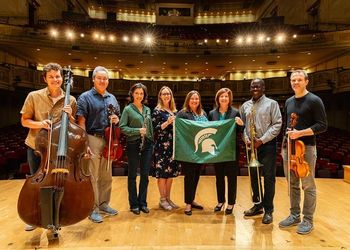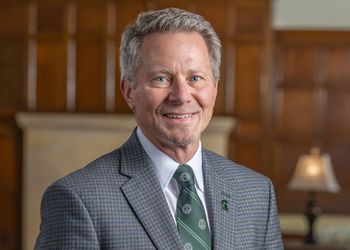Feature: MSU's Iconic Professors

MSU’S ICONIC PROFESSORS
Who are the most notable professors in MSU history? As Michigan State nears its Sesquicentennial, it’s clear this question has no easy answer. In its first 148 years, the university has boasted an enormous number of distinguished faculty who have significantly advanced the frontiers of knowledge, enriched student learning, and helped to improve the quality of life of Michigan citizens.
Jim Sheppard, manager of the MSU Union, wanted to honor the most prominent of MSU’s great professors—a select group he calls “MSU’s iconic professors”—with life-size murals in the Union’s Heritage Café. He assembled the Faculty Recognition Committee*, which sought nominations from all colleges for names of outstanding faculty members, no longer alive, whose contributions were so significant they need to be remembered by future generations. The committee selected 13 faculty members who are described here. The murals, reproduced below, were painted by Okemos artist Lori Lechler.
The following profiles of MSU’s iconic professors are written by Fred Honhart, director of University Archives and Historical Collections and a member of the Faculty Recognition Committee. --Editor.
William J. Beal (1833-1924) was born in Adrian, Michigan, and raised on a farm. He attended the University of Michigan and graduated with a B.A. in Classical Studies (1859). He taught for two years before enrolling at Harvard, where he earned a B.S. degree. In 1870 he came to the State Agricultural College, where he taught botany and forestry for forty years. He was widely regarded as an outstanding teacher, and many of his students went on to become leaders in their fields, including Liberty Hyde Bailey. Beal was also an internationally recognized leader for the research he did in his field. Among his most notable research achievements were his studies with cross-fertilization of corn, leading to the development of hybrid corn plants, the basis for modern agriculture. During the course of his cross-fertilization work he corresponded with Charles Darwin on the topic. He also created the botanical garden at MSU, which bears his name and is the oldest such garden in the United States. In addition to several highly regarded scientific books, Beal wrote the first history of MSU (published in 1915) after his retirement in 1910.
Robert C. Kedzie (1823-1902) was born in Delhi, New York and moved with his family to Michigan in 1826. At the age of 17 he enrolled at Oberlin College and graduated in 1846. Two years later he was among the first class of the medical school at the University of Michigan, receiving his M.D. in 1851. He practiced medicine for 11 years. During the Civil War he served in the 12 Michigan Infantry. At the battle of Shiloh he was captured by the Confederates. After several months of captivity he was released due to poor health. On February 25, 1863 he began he career as Professor of Chemistry at Michigan Agricultural College. He would remain in that position for over 39 years, and became one of the most revered and respected teachers on the campus. He served a term in the Michigan Legislature, and was responsible through his research in creating the sugar beet industry in Michigan. A strong advocate of vigorous public health, he identified the fatal use of arsenic in wallpaper and through legislation abolished its use in Michigan. He also developed state regulations for the safe production and quality standards for illuminating oils which in the past had caused injury and death due to poor quality products. The inspection of commercial fertilizers and the establishment of a state food and dairy commission to make sure the people of the state were being sold products that were safe and met established quality standards, were among his other contributions to Michigan’s public health. His sons, William, Robert and Frank all followed in their father’s academic footsteps, with Frank serving as a member of the MSU faculty and President , 1915-1921.
Albert John Cook (1842-1916) was born and raised on the family farm in Owosso, Michigan. With his father's strong encouragement he attended Michigan Agricultural College (MAC), graduating in 1862 and then earning a Master's of Science in 1865. In 1867-68 he spent a year studying at Harvard. He was initially appointed to teach mathematics at MAC in 1867, but in 1869 was appointed Professor of Zoology and Entomology, and later Curator of the Museum, positions he held until 1893. He also served as "Entomologist" at the Michigan Agricultural Experiment Station from 1888 to 1893. Professor Cook was a pioneer in developing insecticides farmers could use to protect their crops against such pests as the codling moth. He was the first professor to teach beekeeping in the United States, helped found the Michigan Beekeepers Association, and for several years was President of the National Beekeepers Association. When the U.S. Postal Service banned the shipment of queen bees in the mail, Cook was able to discuss the situation with President Rutherford B. Hayes and get the Postal Service to reverse its ruling. During his tenure at MAC he worked tirelessly with the state legislature to promote the interests of the College. In 1893 he resigned his position to move to California as a professor at Pomona College in the hope that it would improve his wife's ailing health. He went on to serve the state of California as State Commissioner of Horticulture until he returned to Michigan in 1916.
Linda Landon, (1856-1942) was the College Librarian from 1891 to 1932. She was born in Peekskill, New York, and later moved to Niles, Michigan. After the death of her husband in 1886 she taught in the Kalamazoo public schools. In 1891 she came to MAC to become the school’s fifth librarian. When she came to the State Agricultural College, the Library consisted of a book collection of 14,000 volumes, most of which were not cataloged. During her tenure the collection was cataloged and grew to over 80,000 volumes, vastly increasing the intellectual resources for faculty and students. More important she was able to see her dream of new Library, the current MSU Museum building, completed in 1924 at a cost of $460,000. At the time it was as modern as any college library in the country. As the College Librarian, she was in constant contact with the students, and much beloved by them. For over 40 years she introduced incoming students, and faculty, to the use and collections of the Library. The 1912 College Yearbook, the Wolverine, was dedicated to her, stating “ no person at MAC more deserves the honor of the dedication of this year’s Wolverine than does that amiable, pleasant little lady in black who more that anyone else has been tutoring the thousands of students in the art of appreciating, loving and valuing these true friends in life—books.”
Kenyon Butterfield (1868-1935) was born and raised on the family farm in Lapeer, Michigan. He attended Michigan Agricultural College, where he was elected president of many student organizations, including his class. At MAC he became very interested in improving rural education and social organizations, and this became a determining theme throughout his life. After graduation he was appointed secretary to the President of MAC, edited the Michigan Grange, and worked with the Michigan legislature to fund farmers institutes, workshops on topics of particular interest to farmers held throughout the state. From 1895 to 1900 he was Michigan State Superintendent of the institutes and in 1898 urged the College to create a program designed to improve the quality of life in rural Michigan. This led to an effort to create a similar program on a national level. As a result he was appointed by President Theodore Roosevelt to the Commission on Country Life in 1908. While the Commission quickly faded from the scene, the lobbying effort continued to create a national extension service. This was accomplished with the passage of the Smith-Lever Act in 1914, and the effects of the Extension Service have been felt by millions of Americans over the last eight decades. The creation of the Extension Service is due in no small part to the dedicated and visionary work of Kenyon Butterfield.
I. Forest ("Hudd") Huddleson (1893-1965) was born in Murphysville, Kentucky. He attended Oklahoma Agriculture and Mechanical College, where he received a B.S. degree in 1915, and then came to Michigan Agricultural College as a research assistant. Aside from a two year period when he served in the U.S. Army as a Captain in the Sanitation Corp, 1917-1918, he spent the rest of his career at MSU. He earned a M.S. in 1916, a D.V.M. in 1925 and Ph.D. in 1937, all from MSU. Early in his career, Huddleson worked with Leslie Cooledge on a research project to determine the cause of Brucellosis (Bang’s disease), which was a major problem for the livestock industry. Contrary to Cooledge's earlier conclusions, Huddleson and others later presented evidence that the causative agent, B. abortus, could also infect humans. The disease in humans (known as undulant fever) could be debilitating for long periods of time. The dairy industry in Michigan estimated that in 1947 alone it lost eight million dollars due to Brucellosis-infected milk that had to be destroyed. Huddleson developed a means to detect Brucella bacteria in animals and also a product, “Brucellin”, for the treatment of the disease. Both of these were produced at MSU and then distributed worldwide. Huddleson also developed a procedure for treating people with the most advanced stages of the infection, that otherwise could be fatal. He traveled throughout the world assisting other countries with the treatment of the disease and received numerous awards, including the first Borden Award from the American Veterinarian Medical Association in 1944 and the Kimble Award from the American Public Health Association. Huddleson believed in a broad education and claimed his interest and study of art and color were of considerable use in his research. Among the students trained at MSU was Dr. Alfred H. Hershey, who went on to receive the Nobel Prize in Physiology and Medicine in 1969.
Russel Blaine Nye (1913-1993) was born in Viola, Wisconsin. He graduated from Oberlin College in 1934 and then enrolled at the University of Wisconsin, where he earned his M.A. and Ph.D. He began teaching at Michigan State College in 1941 and remained a faculty member until his retirement in 1979. His first book, George Bancroft:Brahmin Rebel, won the 1945 Pulitzer Prize for Biography. Professor Nye is the only MSU faculty member to have been awarded a Pulitzer Prize. In a productive career of scholarlarship Professor Nye published and edited well over thirty major books. The topics included studies of the slavery controversy and abolitionism, cultural life and literary developments, midwestern politics, and biography. His 1970 book, The Unembarrassed Muse: The Popular Arts in America, was a landmark work in defining the field of popular culture studies and documenting extensively the rich culture of the “common American.” With Ray B. Browne, Dr. Nye was a co-founder of the Popular Culture Association in 1969 and served as the organization’s first President. He also served as President of the American Studies Association from 1965-1967. Dr. Nye’s scholarship is noteworthy for its range, diversity, and wealth of original documentation. He was generous with his knowledge and contributed to the development of graduate students and future scholars by directing numerous dissertations. He donated his substantial popular culture collection to the MSU Library, thus establishing one of the best research sites in the country.
Ralph F. Turner (1917-1994), was born in Milwaukee, Wisconsin, and studied at the University of Wisconsin. He received his B.S. degree in Chemistry in 1939 and then moved to Kansas City, Missouri, where he established the Police Laboratory of Forensic Science. He left Kansas City in 1947 for Michigan State College where he was Professor of Criminalistics in the School of Criminal Justice. In 1957 he earned a M.S. in Police Administration from the University of Southern California while on leave from MSU. His research on the effects of alcohol led to a better understanding of its affects on driving, for which he received national recognition. He was also an expert in firearms identification and ballistics, served on the select panel to review the assassination of Robert F. Kennedy, was a founding member and first Secretary-Treasurer of the American Academy of Forensic Science. He worked for the prosecution and the defense as an expert witness in over 300 cases during a period of five decades. Ralph loved to travel and served with several MSU international projects, including ones in Germany, Vietnam, and Taipei. In 1978 he was the third person to be awarded the Bruce Smith Award from the Academy of Criminal Justice Sciences, given in recognition for a lifetime of leadership in the field. In 1981, the year he retired, he received the MSU Distinguished Faculty Award. His greatest professional accomplishments were his students, whom he kept in touch with throughout his life.
Beatrice Paolucci (1920-1983) was a professor at Michigan State University for nearly thirty years (1951-52; 1956-57; 1958-1983). She was a commanding figure in raising and broadening the theoretical foundations of home economics and study of the family. She set the pace in applying an ecological model in the field and articulating how the world's ecological health, the development of human resources, and the quality of life depend on decisions and actions taken not only by nations, but by families. A recognized and respected leader of the professoriat at Michigan State University, she provided insight and counsel on many academic issues, notably during the turbulent days of the 1970s. She was a stimulus to many faculty and academic units for collaborative projects related to children, youth, and families. A dynamic teacher, she influenced numerous students who became leaders around the world in human ecology, family study, and family and consumer sciences (the name by which the field is now known). Books she co-authored, Teaching Home Economics, and Family Decision Making: An Ecological Approach, were standard texts for many Home Economics departments. She received many professional and academic honors, including the MSU Distinguished Faculty Award in 1968. In 1970 she was a vice-chair of the White House Conference on Children.
James Sutherland Frame (1907-1997) was born in New York City. He attended Harvard University, where he received his B.A., M.A. and a Ph.D. in mathematics in 1933. He taught at Brown University and Allegheny College before coming to Michigan State University in 1943 as Chair of the Department of Mathematics, in which capacity he served until 1960. Along with his position in Mathematics, he also had an appointment in Engineering. He retired in 1977. Throughout his career he was devoted to teaching, and after his retirement he and his wife, Emily, personally endowed an annual award for outstanding teaching of mathematics at MSU. He founded the first chapter of Pi Mu Epsilon, a mathematics organization for undergraduates, at MSU, and was active in making it a national organization, with numerous chapters established at many other colleges and universities. The Mathematical Association of America honored him in two ways. Starting in 1973, an annual lecture at the Association’s summer meeting was named after him; and, in 1994 he was awarded the Association’s Yueh-Gin Gung and Dr. Charles Y. Hu Award for Distinguished Service to Mathematics. He received the MSU Distinguished Faculty Award in 1967. “Sud” Frame was an internationally acclaimed research mathematician with over 100 publications, many of which dealt with the representation theory of finite groups. He was also an active member of the East Lansing community, serving a term on the Board of Education.
Walter Adams (1922-1998) was born in Vienna, Austria, and immigrated to the United States with his parents in 1934. He graduated from Brooklyn College in 1942 and entered the U.S. Army in 1943. He landed at Normandy with the 83rd Infantry on June 19, 1944, and served with distinction, earning the Bronze Star Medal and five bronze campaign stars, and was involved in the liberation of three concentration camps. After the war he entered graduate school at Yale University, M.A. 1945 and Ph.D. 1947 in economics. In 1947 he came to Michigan State College as an economics professor, beginning a teaching career that would earn him numerous plaudits for his commitment to teaching and his students. He was named as one of the top ten professors in the country by Rolling Stone Magazine in 1991. Don Riegle, a former Adams’ student and U. S. Senator from Michigan said, “It was a great honor and privilege to be a student of his. He was truly an inspired teacher. “ Walter Adams was also an internationally recognized scholar, writing numerous books, many of which dealt with anti-trust economic issues. He was nationally regarded for his scholarship on this topic and in constant demand as an expert on the issue, often testifying before Congressional committees. His publications included such works as, The Brain Drain, Monopoly in America, The Tobacco Wars, A Guide to Study Abroad, and The Test. In 1960 he received the Distinguished Faculty Award for his teaching and scholarship. He served as President of MSU, 1969-1970. One of his favorite activities was his support of the MSU Marching Band, for which he received an honorary membership in the organization. In recognition of his services to MSU the Board of Trustees in 1999 named the practice field next to Cowles House Walter Adams Field.
William Harrison Pipes, (1912-1981) was Michigan State University’s first African-American professor. He was a member of the Department of American Thought and Language from 1957-1976. Born in Inverness, Mississippi, the son of cotton sharecroppers he went to public schools through the 6th grade; at that time Mississippi did not allow Negro students to go further. He worked his way through Tuskegee Institute High School and College in Alabama. He subsequently earned a M.A. from Atlanta University and a Ph.D. from the University of Michigan, the first African-American to earn a Ph.D. in speech. Prior to coming to Michigan State University, he was President of Alcorn College from 1945 to 1949. He taught at Fort Valley State College in Georgia, 1940-43; Southern University in Louisiana 1943-1945; and was Dean and Professor of Speech At Philander Smith College, 1949-1956. He taught at Wayne State University, 1956-1957. He is remembered for his strong and interesting lectures and interest in his students. For ten years he was the editor of the The Cresent, Phi Beta Sigma’s fraternity magazine, and active in establishing new chapters at several college campuses. Professor Pipes was the author of several books, including The English Major; Say Amen, Brother; Is God Dead; andDeath of an ‘Uncle Tom’. During his career he received Rosenwald and Fulbright study grants. He was married to Anna H. Russell Pipes, who taught at MSU and Lansing Community College. He was the father of Harriette Pipes McAdoo, Ph.D., MSU University Distinguished Professor, Willetta Pipes Ewing, and William Pipes, all of whom attended Michigan State University.
Julian Samora(1920-1996) was born in Pagosa Springs, Colorado. He received a B.A. from Adams State College in 1942 and an M.S. from Colorado State University-Fort Collins in 1947. He earned a Ph.D. in Sociology from Washington University-St. Louis in 1953. Dr. Samora was the first Mexican-American to earn a Ph.D. in Sociology. Subsequently, Dr. Samora held several teaching positions, including Assistant Professor in Sociology and Anthropology at Michigan State University, 1957 -1959. In 1959 he moved to the University of Notre Dame as an associate professor in Sociology. He later served as chair of the Sociology and Anthropology Department at Notre Dame from 1963-66. He retired in 1985. Dr. Samora was a pioneer in the fields of Chicano Studies and the study of the U.S.-Mexico border. He did this at a time when universities were reluctant to sponsor research critical of United States institutions and society. He was one of the co-founders of the National Council of La Raza, the leading Hispanic civil rights organization, and he helped create the Mexican-American Legal Defense and Education Fund (MALDEF), an organization affecting bilingual education and immigration nationwide. While at Notre Dame, he directed the Mexican-American Graduate Studies Program, from 1971-1985, in which over 50 students, primarily Mexican-American, obtained advanced degrees in Sociology, History, Law, Psychology, Economics, and Political Science. Among the boards and commissions he served on were the U.S. Commission on Civil Rights, National Institute of Mental Health, and the President’s Commission on Rural Poverty. For his work he received, in 1990, the Orden Del Aguila Azteca, Mexico’s highest honor to a foreign national. In 1994, Dr. Samora received the Keys to the City of Los Angeles, and a Lifetime Achievement Award from the California State Polytechnic University, Pomona. A prolific writer, Samora published nearly 30 articles and books including: La Raza: Forgotten Americans (1966); Mexican-Americans in a Midwest Metropolis (1967); Los Mojados: The Wetback Story (1971); andGunpowder Justice: A Reassessment of the Texas Rangers (1979). He served as an editor for numerous publications including the International Migrant Review and Nuestro. In 1989 Michigan State University created the Julian Samora Research Center, the first U. S. Hispanic to have a university research center named in his honor.



